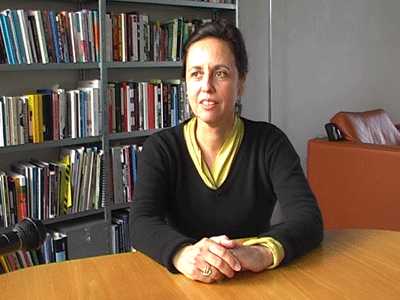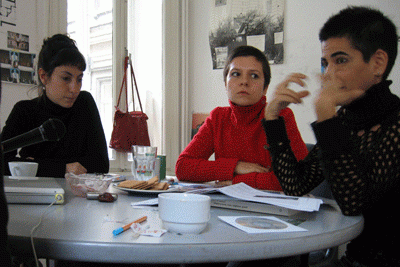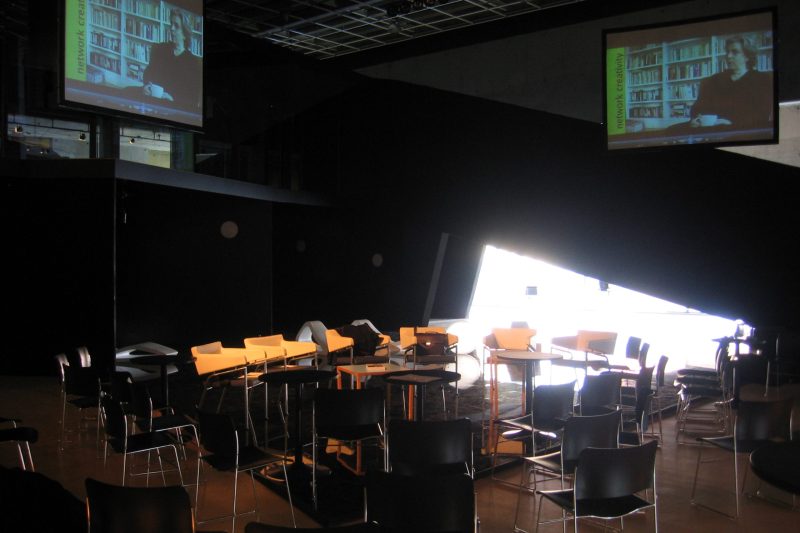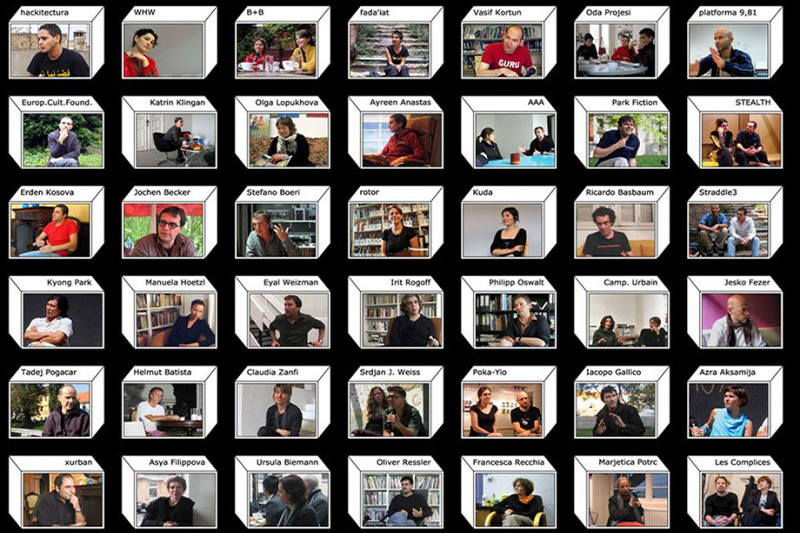- Interview
- NETWORKED CULTURES
conversation with Ursula Biemann
PM/HM: The Maghreb Connection is a collective undertaking that relates more to producing new knowledge than accumulating art in a traditional curatorial context. What is the significance of this kind of research in which you meander between curatorial and artistic practice?
Ursula Biemann: I understand my curatorial work as an expansion of my own artistic practice; it’s a way of forming a mutual context. When you speak of transit migration in the Maghreb, including trans-Saharan migration from West Africa, it’s a complex topic and a huge geography with lots of key locations. It’s more than a single person can handle. You have to depend on other people to cover different sections of migration paths, raise specific issues and document different locations: Lampedusa, migration gates in Morocco, the Nile Delta. But it’s a relief to know you can focus on your own small distinct area because the others are elaborating on theirs, and together these works will establish relations across the entire region. We don’t need more reductive representation there. For The Maghreb Connection, I started a network with people I had worked with in the past and others just joined in; for instance, I had heard of a couple who were working on Lampedusa, a crucial location that we had been wanting to cover anyway. The project grew organically over a number of months before we settled into a group. In fact our collaboration turned into a network all by itself; there was no defined collective structure that had us actually sitting around the table and making decisions together, but we shared a lot of information. The aim of our research was to produce new knowledge, so we went on location and gathered a lot of information from people who were involved in migration studies, local NGOs or directly with migrants, and were documenting migration gates, nodes and relays in the mobility network.
In a second phase, we developed diverse artistic projects with this material. In the process we wrote substantial research texts for the publication. This happened at a time when we were in the middle of editing videos and everything was still a construction site. It was during this process of articulation that the collaboration in the group became most intense. The day after the opening in Cairo, we held a conference on migration politics and art, with speakers from, for example, Observatorio Technologico del Estrecho, an activist network on Spanish-Moroccan border issues, as well as Maghrebi scholars doing research in France. The majority of those attending the conference came from Morocco, Lebanon and the larger Middle East – for it was a regional project. The exhibition got a lot of media attention. TV journalists wanted to know more about this unusual curatorial project and they immediately understood that the artworks hadn’t been chosen from a position of authority, but that the whole project had grown in a “workshop” fashion, as one of them called it. They were surprised to see a conference on migration politics set in an art exhibition, especially one where the two were so closely related. They recognised the potential of the art context to trigger a debate in a country where public debate is restricted. The Maghreb Connection continues to grow and new artworks are being developed for an upcoming exhibition in Beirut.
PM/HM: In most of your works there’s an interest in the interaction of all kinds of networked economies with everyday community situations. What can be achieved by bringing these minor encounters and side events to the attention of a wider audience?
Ursula Biemann: To stay with the example of The Maghreb Connection, one of the motivations was clearly to counteract the repetitive simplistic representation of boat people in the media. Unless you take specialised literature, the images reproduced in the media present poor Europe being overwhelmed by an enormous invasion of people who want to enter it. To start with, we felt the need to show that this form of migration is not a problem that has emerged suddenly but a well-grounded social practice with local ties and historical roots. In addition we wanted to open up a whole range of discussions and research subjects around the issue because reductive representations also tend to be misleading. There had to be something to gain from deeper levels of analysis and presenting audiences with the complex web of spatial and social relations we both observed and created during our research. Some of us had a particular interest in spatial configurations, because it is striking how different transnational spaces overlap and intersect in this region. There are all these subversive, clandestine formations, and they exist side by side with high-tech plans to create a giant transnational harbour in the southern section of the Mediterranean Basin. One of the artists from Cairo has been doing work on Chinese migrants who have moved to Cairo. For there is not only migration from the South to the North but also a considerable flow of lateral movement within Africa, a lot of which involves the Chinese.
For my part, I wanted to make the network itself visible by going to some major gates in the Sahara. In Niger, I filmed the departure of sub-Saharan migrants as they were packing and leaving on desert trucks, when everything still seemed possible to them. I filmed these quiet scenes in an unexcited way, like an everyday event. I also interviewed some key figures of the organisation, “coxers”, as they call themselves; and a Tuareg ex-rebel leader who gave his sophisticated analysis of this space of mobility, one that has always been occupied by the Tuareg socially, if not politically, and which they now have repurposed for a giant migration transit business. People have established a web of connections and they use it to move through these vast spaces; this web is also a complex social and not just physical system of underground relay stations. You have to be able to rely on a lot of people, if you want to make it. These networks are mainly fuelled by economic activities that have emerged from them – the desert cities are booming – because everything has to do with survival, and people automatically find ways to capitalise on this. The more furtive the network, the more coded and difficult it is to visualise it. In their spatial organisation these networks are geographic but it’s the sort of geography that has to do with networked thinking rather than with a classical sense of spatial determination.
The clandestine, coded nature of the system and the highly emotional existential stakes involved in the operation make it extremely difficult to find adequate representations. You can capture activities at a number of logistic hubs, even if the rest remains out of sight. What we’re looking at, then, is an off-Broadway play of geopolitics where you only get to see the side events. However, if you were to choose not to deconstruct the powerful players of this web, but set them aside for once, and managed not to fall for simple victimisation clichés, you might start to see how the migrants themselves shape and give meaning to the process. To pay attention to such inventive social practices is a lot more interesting, because it leads to the complexity of social textures. For ultimately there’s no simple way to tell the story of trans-Saharan migration. I think the wider audience knows very little about the finer facets of migration. With our work we can contribute to diversifying the discussion and making it more complex.
PM/HM: Speaking about the ambiguity of informal networks that accompany migration: informal economies are sites of exploitation yet there are also moments of creativity connected to these arenas of survival. What are the implications of artistic investigations into these conflicting worlds, e.g., in your work on the global sex industry?
Ursula Biemann: The condition of women in the global sex industry ranges from forced prostitution to self-determined migration, which means the term itself encompasses these ambiguities. In the trafficking of women you have to look really hard to find any empowering moments, as their bodies and labour are almost entirely governed by others. Many women, the majority I’d say, experience economic exploitation regularly but they also create huge economies in the process, shadow economies and spaces of survival in the cracks of global capitalism. It’s interesting to see exactly how they go about this and at the same time, to subvert the idea that global capitalism is something all-pervasive that has a grip on the whole world, for this is not at all the case. To show how people are constantly subverting this concept is a way to draft counter-geographies. Subverting and circumscribing borders is, of course, the most visible effect of this. There’s a desire for self-determination and a “savoir faire” of migration; simultaneously there are these other technologies developed to manage and control it. These two tendencies are constantly in friction with one another and sites where this friction becomes visible are interesting places.
This became very clear in my research for Remote Sensing. International sex workers have a very strong network, one that has been in the making for over a generation. Some of them even have long-standing relations, as they first began arriving from Southeast Asia at the end of the Vietnam War. This is a history we shouldn’t forget; not everything started with globalisation. First, all you see is the exploitation – the magnitude of exploitation is just unbelievable – and the fact that women are addressed in their sexuality by global capitalism is outrageous. There’s undeniably a sense of sacrifice and victimhood. But after a week or two, the more I spoke with these women, for example, in the Philippines, I had to acknowledge their position, which they spoke about in such normal, unspectacular terms. I entered a different level of conversation and began to see the small things they’ve managed to achieve, including the fact that they help their families to survive. In my video, it’s not so important to state my personal position but to open a range of conflicting positions regarding prostitution and trafficking, including the ethical choice of engaging in sex work. That’s when black-and-white vision blurs and you start to enter a grey area, a zone of negotiation, and this is what I’ve been most interested in over the last years. To open up a discursive space has been one aesthetic strategy, the other has been to invent new images for the transnational mobility and global network, both real and virtual, that these women have created in the process.

Ursula Biemann
geobodies.org
is an artist, theorist and curator working on the gendered dimension of geopolitical displacement and migrant labor. Border and mobility are recurring themes in her video essays from Performing the Border (1999) to Contained Mobility (2004). She initiated the collaborative projects ‘Kültür’ (1997) on Istanbul’s urban politics and ‘B-Zone’, Kunstwerke Berlin (2005) which includes her video research Black Sea Files (2005) on the Caspian oil geography. Her multi-channel video, Sahara Chronicle (2006-2007), was first exhibited at Arnolfini, Bristol in September 2007. Curator of the 2003 exhibitions ‘Geography and the Politics of Mobility’, Generali Foundation, Vienna, and ‘The Maghreb Connection’, Townhouse Gallery, Cairo (2006). She has published numerous books and essays. MISSION REPORTS – Artistic Practice in the Field, an extensive monograph on her practice, was released in 2008. Biemann researches at the Universities of Art and Design in Zurich and Geneva.


